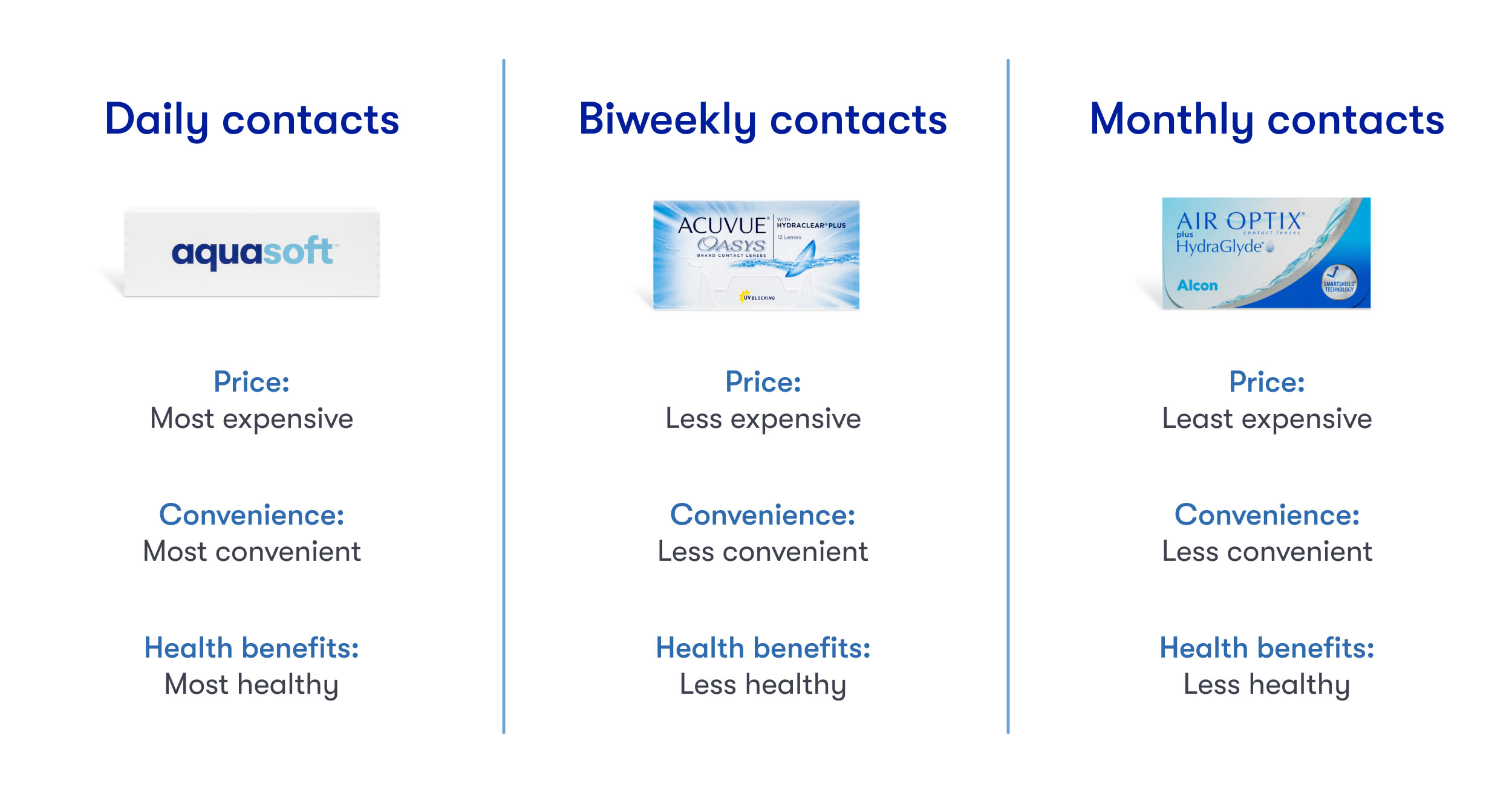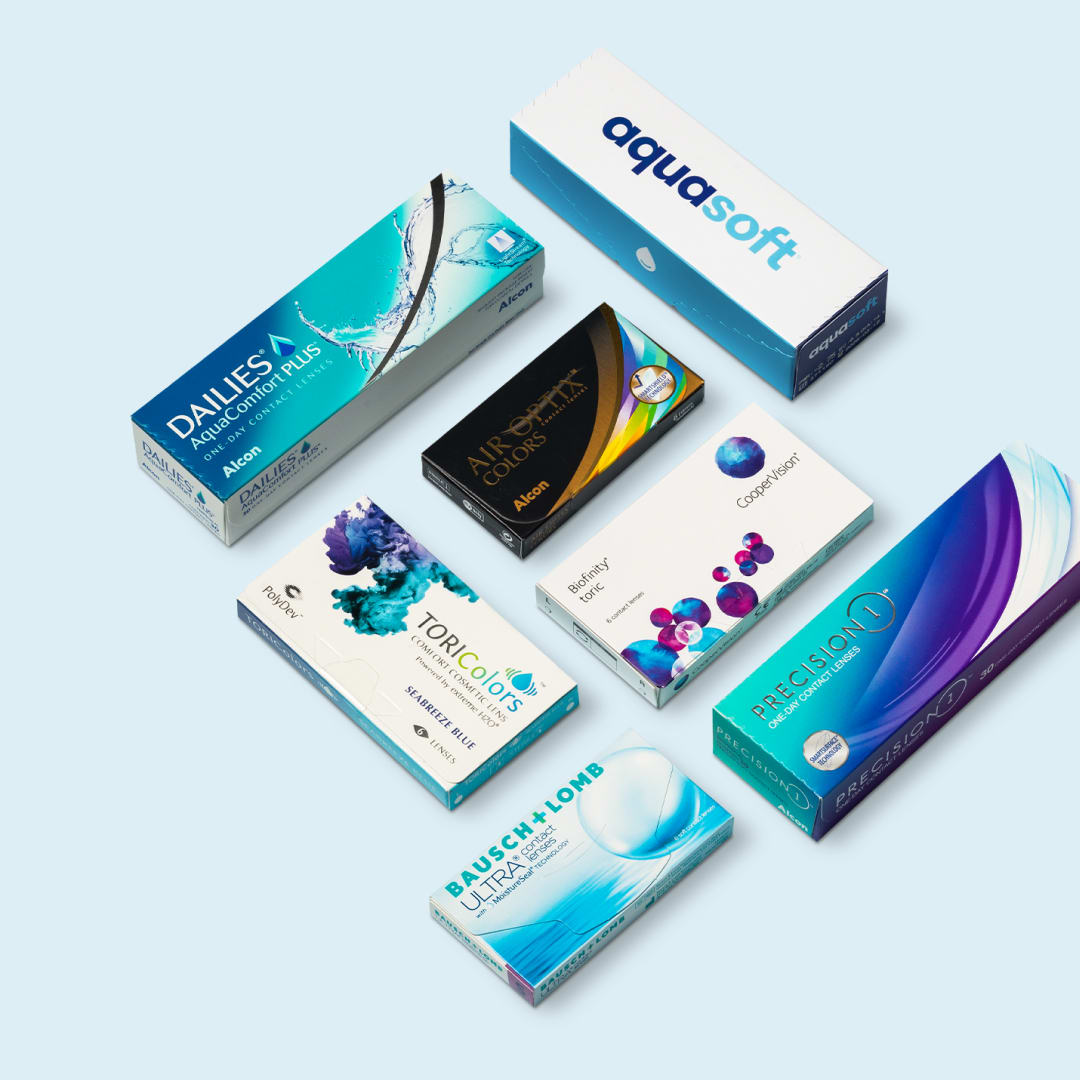Should you get daily, biweekly, or monthly contacts?
If you’ve found yourself squinting at your screen thinking, "Should I get daily, biweekly, or monthly contacts?", you’re not alone. Choosing the right kind of contact lenses is a little like picking a new streaming service: There are lots of options, each with their pros, cons, and terrible, terrible hidden costs (just kidding — no hidden fees here).
Daily, biweekly, and monthly contacts each offer something a little different depending on your prescription, lifestyle, preferences, and budget. Some are more convenient, others more cost-effective, and a few are basically the VIP section of the contact lens world (yes, we’re looking at you, daily lenses).
In this guide, we’ll walk you through each type of contact lens, serve up some real-life examples from our collection, and help you answer that million-dollar (okay, more like $60–$300) question: Which ones are right for you?

Daily contacts
If convenience had a mascot, it would definitely be daily contacts. They’re the ultimate low-maintenance option — no cleaning, no storing, just pop 'em in and go.
What are daily contacts?
Let’s start with the fancy ones. Daily contacts — also called "dailies" or "daily disposable lenses" — are worn for one day and tossed in the trash like that sad, lonely sock with no match. Every morning, you get a fresh new pair. Every evening, you toss them like yesterday’s tuna sandwich someone left on the counter.
How they differ:
-
From bi-weeklies: Dailies are single-use; bi-weeklies you wear for 14 days.
-
From monthlies: Dailies are low-commitment; monthlies are basically a long-term relationship.
Examples of daily contact lenses
-
Acuvue Oasys 1-Day with HydraLuxe: Great for dryness and screen-heavy days (hello, work-from-home life)
-
Dailies AquaComfort Plus Toric: Designed for astigmatism, AKA if your eyes like to live a little off-center
-
Dailies Colors: Because, sometimes, your eyes just need to match your outfit
Pros
-
Super convenient — no cleaning, no storage, no guilt if you lose one
-
Great for allergies (bye, protein buildup)
-
Travel-friendly
-
Feels like wearing nothing at all (which, for contacts, is a good thing)
Cons
-
Cost adds up if you wear them daily (pun intended)
-
Not as eco-friendly — more packaging and daily waste
-
Less ideal for spontaneous sleepovers (unless you pack extras ... or have incredible luck)
Cost
-
Around $30–$60 per box (30 pairs per eye)
-
Adding up to around $60–$120/month for most people
Best for:
-
People with allergies or sensitive eyes
-
Those who value convenience (aka you’re busy or just over cleaning things)
-
Infrequent contact wearers who just use them for sports, events, or Zoom dates
-
Travelers and commitment-phobes (no judgment)
Can you wear daily contacts for 2 days?
Short answer: No.
Long answer: Still no, but here’s why: Daily lenses are made with thinner materials not designed for multiple days of wear. Reusing them can dry out your eyes, increase your risk of infection, and, frankly, just feels gross. Think of them like paper plates — they sure are convenient, but they're also definitely not dishwasher safe.
Are daily lenses safer than monthly?
"Safe" in contact lens terms means less risk of infections, irritation, or turning your eye into a science experiment (no thanks).
Daily lenses are generally considered the safest because:
-
You’re using a fresh, sterile pair every day
-
No cleaning solution means no contamination risk
-
You don’t have time for protein deposits to build up
That said, all our lenses are high-quality and safe if used properly. Even the best lens turns evil if you sleep in it or wear it past its expiration. (Your eye care professional definitely agrees with us here.)

Order Contact Lenses Online
Learn how to order contact lenses online at 1-800 Contacts
Order contacts
Bi-weekly contacts
Bi-weekly lenses strike a happy medium between dailies and monthlies — kind of like the Goldilocks of the contact lens world. They offer a fresh pair feeling more often than monthlies without the daily swap-out routine.
What are bi-weekly contacts?
Bi-weekly contact lenses — aka "2-week lenses" — are worn for up to 14 days but only while you're awake (unless your brand and your eye care professional say it's okay to sleep in them — ask first, snooze later).
How they differ:
-
From dailies: You reuse them but only for 2 weeks.
-
From monthlies: You commit but not for a full month. Think of them as the fling between dailies and monthlies.
Examples of bi-weekly contact lenses
-
Acuvue Oasys with Hydraclear Plus: Popular, comfy, and great for dry or sensitive eyes
-
Acuvue Oasys for Astigmatism: Smooth vision even when your cornea doesn’t want to play by the rules
-
Acuvue Oasys with Transitions: Lenses that adjust to light? It’s like sunglasses and contacts had a high-tech baby
Pros
-
Lower cost than dailies
-
Fewer lenses = less waste (and more space in your bathroom drawer)
-
Generally more breathable than monthly lenses
Cons
-
Need to clean and store them daily
-
Not as fresh as dailies
Cost
-
About $25–$45 per box (6 lenses)
-
$20–$50/month depending on your wear schedule
Best for:
-
People who wear contacts regularly but want a bit more savings than dailies
-
Anyone good at keeping track of dates (hello, calendar apps)
-
Those who want a middle ground — fewer lens changes but more comfort than monthlies
Monthly contacts
If you’re looking for a long-haul option in the contact lens world and you're not afraid of a little commitment, monthly contacts might just be your ride-or-die. They’re built for durability, comfort, and value — perfect for people who like a little consistency in their eye care routine.
What are monthly contacts?
Monthly lenses are designed to be worn for 30 days straight — but, again, only during waking hours unless yours are specifically approved for extended wear (and your eye care professional says it’s cool).
How they differ:
-
From dailies: You keep them for a month instead of one-and-done
-
From bi-weeklies: One lens change a month, not two
Examples of monthly contact lenses
-
Air Optix Night & Day Aqua: FDA-approved for 30 nights of continuous wear (if cleared by your pro)
-
Biofinity: Super breathable and comfy — like sweatpants for your eyes
-
FreshLook Colorblends: Monthly wear meets color vibes
Pros
-
Budget-friendly
-
Fewer lens changes = less hassle
-
Less packaging waste than dailies
Cons
-
Requires daily cleaning and proper storage
-
Greater risk of protein buildup and infections if you’re not careful
-
Not great for allergy-prone eyes
Cost
-
Typically $20–$50 per box (6 lenses)
-
Monthly cost of around $10–$25/month per eye
Best for:
-
Regular contact wearers on a budget
-
People who don’t mind a little daily lens TLC (tender lens care)
-
Those who want less frequent reordering
What happens if you wear monthly contacts for more than a month?
Wearing monthly contacts longer than 30 days = big nope. Over time, lenses build up deposits and become less breathable, upping your risk for eye infections and irritation. Think of it like leaving food in the fridge "just one more day." At some point, it becomes science ... and not the good kind.
How long do monthly contacts last if you don’t wear them every day?
Here’s where things get a little nuanced. Monthly lenses are meant to be replaced 30 days after opening, not after 30 days of wear. So even if you wear them only three times a week, the clock starts ticking on day one. The real risk? Bacteria can still grow even if the lens isn't in your eye daily.
However, if you're alternating with glasses and properly storing your lenses, it's possible to extend their safe use a bit — just consult your eye care professional. (And maybe don’t push it.)
Can you switch from daily to monthly lenses?
Short answer: Yes.
Longer, smarter answer: As long as your prescription supports it and your eye care professional gives the green light, you absolutely can switch from daily to monthly lenses. Just know they require a little more maintenance and responsibility (like adopting a plant that doesn’t water itself).
Daily vs. monthly vs. bi-weekly contacts
Okay, let’s wrap it up.
Here’s what you need to know in a nutshell:
Dailies are the MVPs of convenience. You pop in a fresh pair every morning and toss them at night — no cleaning, no cases, no protein buildup, no fuss. They’re especially great for people with allergies, dry eyes, or commitment issues (just kidding ... kind of). They're also the most hygienic option, which makes eye doctors do a happy dance. The only downside? They tend to be pricier overall, especially if you're wearing them every day. But hey, convenience comes at a cost.
Bi-weeklies sit right in the middle of the road, which isn’t a bad place to be. You change them out every 2 weeks, which is often enough to stay pretty fresh but not so often that you're always opening new packs. They’re more affordable than dailies and slightly lower-maintenance than monthlies. However, they do still require daily cleaning and storage, and if you lose track of when to switch them, things can get a little ... fuzzy (literally and metaphorically).
Monthlies are the budget champions. You get 30 days of wear per pair, as long as you clean them diligently every night and store them properly. That means rubbing, rinsing, soaking — the whole bedtime lens spa. If you’re consistent and a bit of a routine-lover, these could be your best bet. But if you're forgetful or lazy with cleaning (no shame), you might be risking irritation or infection. Not ideal.
So, what's the right move? It really depends on:
-
How often you wear contacts
-
Your eye health and any conditions like dryness or allergies
-
Your schedule and lifestyle
-
Your budget
-
And how much effort you’re willing to put into lens hygiene (no judgment — we all have our lazy days)
Bottom line: Pick the lens that works for your life, eyes, and vibe.
We carry all these types at 1-800 Contacts, and our team is always here to help you make the right call (even if your call is, "Please help me, I have no idea what I’m doing"). Need help picking your perfect lenses? We’ve got your back (and your eyes). Browse our full lineup of daily, bi-weekly, and monthly lenses right here.
Did you know you can order contacts online?
Say goodbye to trips to the eye doctor and hello to convenience! With 1-800 Contacts, you can easily order your contact lenses online and have them delivered straight to your door. Plus, our online vision exam makes it simple to get the prescription you need without leaving home. And the best part? You’ll save money on your first order with 1-800 Contacts. It’s never been easier to get your contacts!
FAQ
Should I get daily biweekly or monthly contacts?
It depends on your lifestyle, budget, and how often you want to clean your lenses. Dailies = convenient, monthlies = cost-effective, bi-weeklies = the middle path.
Can you wear daily contacts for 2 days?
Nope. They’re 1-day wonders. Reusing them increases your risk of discomfort and eye infections.
What happens if you wear monthly contacts for more than a month?
You risk buildup, irritation, and infections. Always follow the recommended wear time — even if they "feel fine."
Can you switch from daily to monthly lenses?
Yes, with the blessing of your eye care professional. But be ready for a little more upkeep.
Original publish date: 8/19/22
Updated date: 6/10/25





